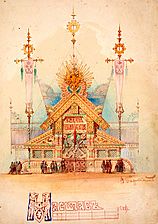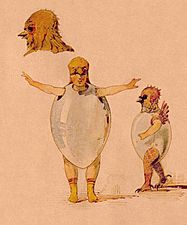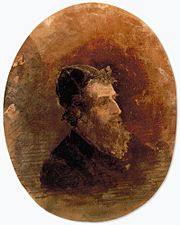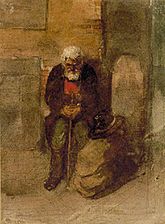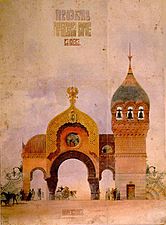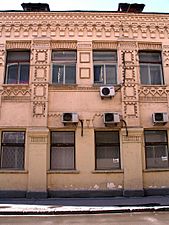Viktor Hartmann facts for kids
Quick facts for kids
Viktor Hartmann
|
|
|---|---|
| Виктор Александрович Гартман | |
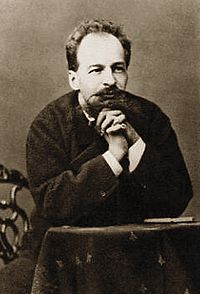
Viktor Hartmann
|
|
| Born | April 23, 1834 |
| Died | July 23, 1873 (aged 39) Moscow Governorate
|
| Education | Member Academy of Arts (1870) |
| Alma mater | Imperial Academy of Arts (1861) |
| Known for | Architecture, Painting |
| Awards | |
Viktor Alexandrovich Hartmann (in Russian: Ви́ктор Алекса́ндрович Га́ртман; born May 5, 1834, in Saint Petersburg – died August 4, 1873, in Kireyevo near Moscow) was a very talented Russian architect and painter. He was known for his connection to the Abramtsevo Colony, a special place for artists. This colony was bought and protected starting in 1870 by Savva Mamontov. Hartmann was also part of the Russian Revival art movement.
Contents
Early Life and Artistic Beginnings
Viktor-Edouard Hartmann was born in Saint Petersburg. His family had German roots. He became an orphan when he was very young. He then grew up with his mother's sister, L. Hemilian, and her husband, Alexandre Hemilian. Alexandre Hemilian was a well-known architect.
Viktor studied at the Academy of Fine Arts in Saint Petersburg. At first, he began his career by drawing pictures for books.
Architectural and Artistic Work
Viktor Hartmann also worked as an architect. He created many sketches and designs. One of his famous works was the design for the monument to the thousandth anniversary of Russia. This monument is located in Novgorod and was officially opened in 1862.
He made most of his beautiful watercolor paintings and pencil drawings during his trips abroad. These journeys took place between 1864 and 1868. Viktor Hartmann was one of the first artists to use traditional Russian designs in his artwork. He often worked alongside Ivan Ropet.
Friendship and Legacy
In 1870, Vladimir Stasov introduced Viktor Hartmann to a group of artists led by Mily Balakirev. From then on, Hartmann became a close friend of the famous composer Modest Mussorgsky.
Sadly, Hartmann passed away at the young age of 39 due to a sudden illness. After his death, an exhibition of his artwork was held. More than 400 of his paintings were shown at the Academy of Fine Arts in Saint Petersburg. This exhibition took place in February and March of 1874.
This art show deeply inspired his friend, Modest Mussorgsky. It led Mussorgsky to compose his famous music piece, Pictures at an Exhibition. Most of the artworks shown at that 1874 exhibition are now lost.
Gallery
-
Design for the Naval department of Russia's pavilion at the Vienna World Fair of 1873
See also
 In Spanish: Víktor Hartmann para niños
In Spanish: Víktor Hartmann para niños
- List of Russian artists


